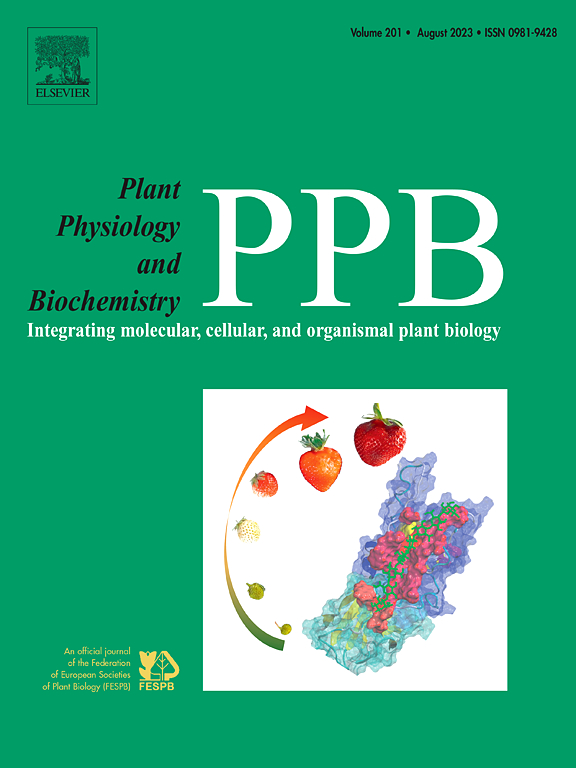脱落酸信号的天然调节剂:多酚基拮抗剂及其在ABA受体调节中的作用
IF 5.7
2区 生物学
Q1 PLANT SCIENCES
引用次数: 0
摘要
植物激素脱落酸(ABA)在调节包括种子休眠、发芽和胁迫反应在内的植物基本过程中起着关键作用。ABA信号是由PYR/PYL/RCAR受体介导的,这些受体与进化枝A PP2C磷酸酶相互作用,控制下游信号通路。结构生物学的进步促进了合成ABA调节剂的开发,如激动剂和拮抗剂,它们可以增强或抑制农业应用中的ABA信号。然而,合成调节剂的高生产成本和潜在毒性促使人们寻找天然替代品。在这里,我们探索了多酚类植物次生代谢物作为ABA受体的生态友好型非规范配体的潜力。通过虚拟筛选和结构分析,我们确定香豆酸和其他羟基肉桂酸是天然的ABA拮抗剂。这些化合物与ABA竞争受体结合,破坏了PYR/PYL蛋白对PP2C磷酸酶的ABA依赖性抑制。因此,它们抵消了拟南芥中aba施加的胁迫反应,促进种子萌发和幼苗建立。进一步的化学优化得到了基于羟基肉桂酸和天然氨基酸偶联物的改进的ABA拮抗剂。它们在植物中的应用为合成调节剂提供了一种可持续的替代品,并为作物管理开辟了新的生物技术战略。此外,我们的研究结果强调了通过ABA受体与内源性羟基肉桂酸的相互作用来微调体内ABA受体活性的机制。本文章由计算机程序翻译,如有差异,请以英文原文为准。

Natural modulators of abscisic acid Signaling: Insights into polyphenol-based antagonists and their role in ABA receptor regulation
The phytohormone abscisic acid (ABA) plays a pivotal role in regulating essential plant processes, including seed dormancy, germination, and stress responses. ABA signaling is mediated by PYR/PYL/RCAR receptors, which interact with clade A PP2C phosphatases to control downstream signaling pathways. Advances in structural biology have enabled the development of synthetic ABA modulators, such as agonists and antagonists, which can enhance or inhibit ABA signaling for agricultural applications. However, the high production costs and potential toxicity of synthetic modulators have motivated the search for natural alternatives. Here, we explore the potential of polyphenols, a class of plant secondary metabolites, as eco-friendly non-canonical ligands for ABA receptors. Through virtual screening and structural analysis, we identified coumaric acid and other hydroxycinnamic acids as natural ABA antagonists. These compounds compete with ABA for receptor binding, disrupting the ABA-dependent inhibition of PP2C phosphatases by PYR/PYL proteins. As a result, they counteract ABA-imposed stress responses in Arabidopsis thaliana, promoting seed germination and seedling establishment. Further chemical optimization yielded improved ABA antagonists based on hydroxycinnamic acid and natural amino acid conjugates. Their use in plants provides a sustainable alternative to synthetic modulators and opens new biotechnological strategies for crop management. In addition, our findings highlight a mechanism for fine-tuning ABA receptor activity in vivo through the interaction of ABA receptors with endogenous hydroxycinnamic acids.
求助全文
通过发布文献求助,成功后即可免费获取论文全文。
去求助
来源期刊
CiteScore
11.10
自引率
3.10%
发文量
410
审稿时长
33 days
期刊介绍:
Plant Physiology and Biochemistry publishes original theoretical, experimental and technical contributions in the various fields of plant physiology (biochemistry, physiology, structure, genetics, plant-microbe interactions, etc.) at diverse levels of integration (molecular, subcellular, cellular, organ, whole plant, environmental). Opinions expressed in the journal are the sole responsibility of the authors and publication does not imply the editors'' agreement.
Manuscripts describing molecular-genetic and/or gene expression data that are not integrated with biochemical analysis and/or actual measurements of plant physiological processes are not suitable for PPB. Also "Omics" studies (transcriptomics, proteomics, metabolomics, etc.) reporting descriptive analysis without an element of functional validation assays, will not be considered. Similarly, applied agronomic or phytochemical studies that generate no new, fundamental insights in plant physiological and/or biochemical processes are not suitable for publication in PPB.
Plant Physiology and Biochemistry publishes several types of articles: Reviews, Papers and Short Papers. Articles for Reviews are either invited by the editor or proposed by the authors for the editor''s prior agreement. Reviews should not exceed 40 typewritten pages and Short Papers no more than approximately 8 typewritten pages. The fundamental character of Plant Physiology and Biochemistry remains that of a journal for original results.

 求助内容:
求助内容: 应助结果提醒方式:
应助结果提醒方式:


